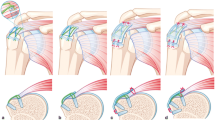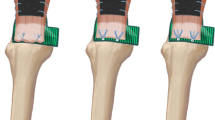Abstract
Background
Interpositional synthetic patch repairs are a novel method of treating massive irreparable rotator cuff tears. However, surgeons experience difficulty in the arthroscopic insertion of these patches.
Questions/Purposes
We compared two methods of arthroscopic interpositional synthetic patch repair: the newly devised slide-and-grip technique, using pre-loaded sliding knots and no arthroscopic knots, and the weave technique, using less arthroscopic knot tying than the earlier mattress technique. Study questions were as follows: (1) Would the slide-and-grip technique take less time than the weave technique? (2) Would the biomechanical strength of the two methods be comparable?
Methods
Fourteen paired ovine infraspinatus tendon ex vivo models of the degenerative human rotator cuff underwent timed repair with a synthetic polytetrafluoroethylene (PTFE) patch, using either the weave technique (n = 7) or the slide-and-grip technique (n = 7). Each was pulled to failure using a tensile testing machine, the Instron 8874.
Results
The time to complete the slide-and-grip repairs was shorter (12 ± 0.9 min) than that of the weave repairs (23 ± 1 min). Ultimate load to failure was comparable for the slide-and-grip and weave techniques (211 ± 27 N vs. 295 ± 35 N, respectively), and the slide-and-grip was less stiff (14 ± 1 N/mm vs. 19 ± 1 N/mm).
Conclusions
The slide-and-grip technique took less time than the weave technique for the interpositional patch repair of massive irreparable rotator cuff tears and when correctly performed had comparable biomechanical strength.






Similar content being viewed by others
References
Andres BM, Lam PH, Murrell GA. Tension, abduction, and surgical technique affect footprint compression after rotator cuff repair in an ovine model. J Shoulder Elbow Surg. 2010;19(7):1018–1027.
Cho NS, Rhee YG. The factors affecting the clinical outcome and integrity of arthroscopically repaired rotator cuff tears of the shoulder. Clin Orthop Surg. 2009;1(2):96–104.
Chung SW, Kim JY, Kim MH, Kim SH, Oh JH. Arthroscopic repair of massive rotator cuff tears: outcome and analysis of factors associated with healing failure or poor postoperative function. Am J Sports Med. 2013;41(7):1674–1683.
Clavert P, Kempf JF, Bonnomet F, Boutemy P, Marcelin L, Kahn JL. Effects of freezing/thawing on the biomechanical properties of human tendons. Surg Radiol Anat. 2001;23(4):259–262.
Galatz LM, Ball CM, Teefey SA, Middleton WD, Yamaguchi K. The outcome and repair integrity of completely arthroscopically repaired large and massive rotator cuff tears. J Bone Joint Surg Am. 2004;86-A(2):219–224.
Gazielly DF, Gleyze P, Montagnon C. Functional and anatomical results after rotator cuff repair. Clin Orthop Relat Res. 1994;(304):43–53.
Gerber C, Fuchs B, Hodler J. The results of repair of massive tears of the rotator cuff. J Bone Joint Surg Am. 2000;82(4):505–515.
Ladermann A, Denard PJ, Collin P. Massive rotator cuff tears: definition and treatment. Int Orthop. 2015;39(12):2403–2414.
McKeown A, Beattie RF, Murrell GA, Lam PH. Biomechanical comparison of expanded polytetrafluoroethylene (ePTFE) and PTFE interpositional patches and direct tendon-to-bone repair for massive rotator cuff tears in an ovine model. Shoulder Elbow. 2016;8(1):22–31.
Peters KS, Lam PH, Murrell GA. Repair of partial-thickness rotator cuff tears: a biomechanical analysis of footprint contact pressure and strength in an ovine model. Arthroscopy. 2010;26(7):877–884.
Ronquillo J, Briggs L, Lam P, Murrell G. Morphologic changes of synthetic (ePTFE) interpositional patch repair for massive irreparable rotator cuff tear: a short-term prospective clinical study. Tech Shoulder Elb Surg. 2013;14(3):73–80.
Ronquillo J, Lam P, Murrell G. Arthroscopic ePTFE patch repair for irreparable rotator cuff tears: part i: surgical technique and biomechanical comparison of 2-suture techniques at the patch to tendon interface. Tech Shoulder Elb Surg. 2013;14(2):29–32.
Ronquillo J, Lam P, Murrell G. Arthroscopic ePTFE patch repair for irreparable rotator cuff tears: part ii: preliminary clinical results. Tech Shoulder Elb Surg. 2013;14(2):33–41.
Shepherd H, Murrell GA. Use of synthetic patches as tendon substitutes in knotless arthroscopic repairs of massive rotator cuff tears. Tech Shoulder Elb Surg. 2012;13(1):32–35.
Shepherd HM, Lam PH, Murrell GA. Biomechanics of synthetic patch rotator cuff repairs. Tech Shoulder Elb Surg. 2011;12(4):94–100.
Shepherd HM, Lam PH, Murrell GA. Synthetic patch rotator cuff repair: a 10-year follow-up. Shoulder Elbow. 2014;6(1):35–39.
Author information
Authors and Affiliations
Corresponding author
Ethics declarations
Conflict of Interest
Joo Y. Sunwoo, Patrick H. Lam, PhD, and George A.C. Murrell, MD, DPhil, declare that they have no conflict of interest.
Human/Animal Rights
All procedures followed were in accordance with the ethical standards of the responsible committee on human experimentation (institutional and national) and with the Helsinki Declaration of 1975, as revised in 2013.
Informed Consent
N/A
Required Author Forms
Disclosure forms provided by the authors are available with the online version of this article.
Rights and permissions
About this article
Cite this article
Sunwoo, J.Y., Lam, P.H. & Murrell, G.A.C. A Comparison of Two Arthroscopic Techniques for Interpositional Polytetrafluoroethylene Patch Repair for Massive Irreparable Rotator Cuff Tears: Speed and Biomechanics. HSS Jrnl 14, 186–191 (2018). https://doi.org/10.1007/s11420-018-9607-7
Received:
Accepted:
Published:
Issue Date:
DOI: https://doi.org/10.1007/s11420-018-9607-7




